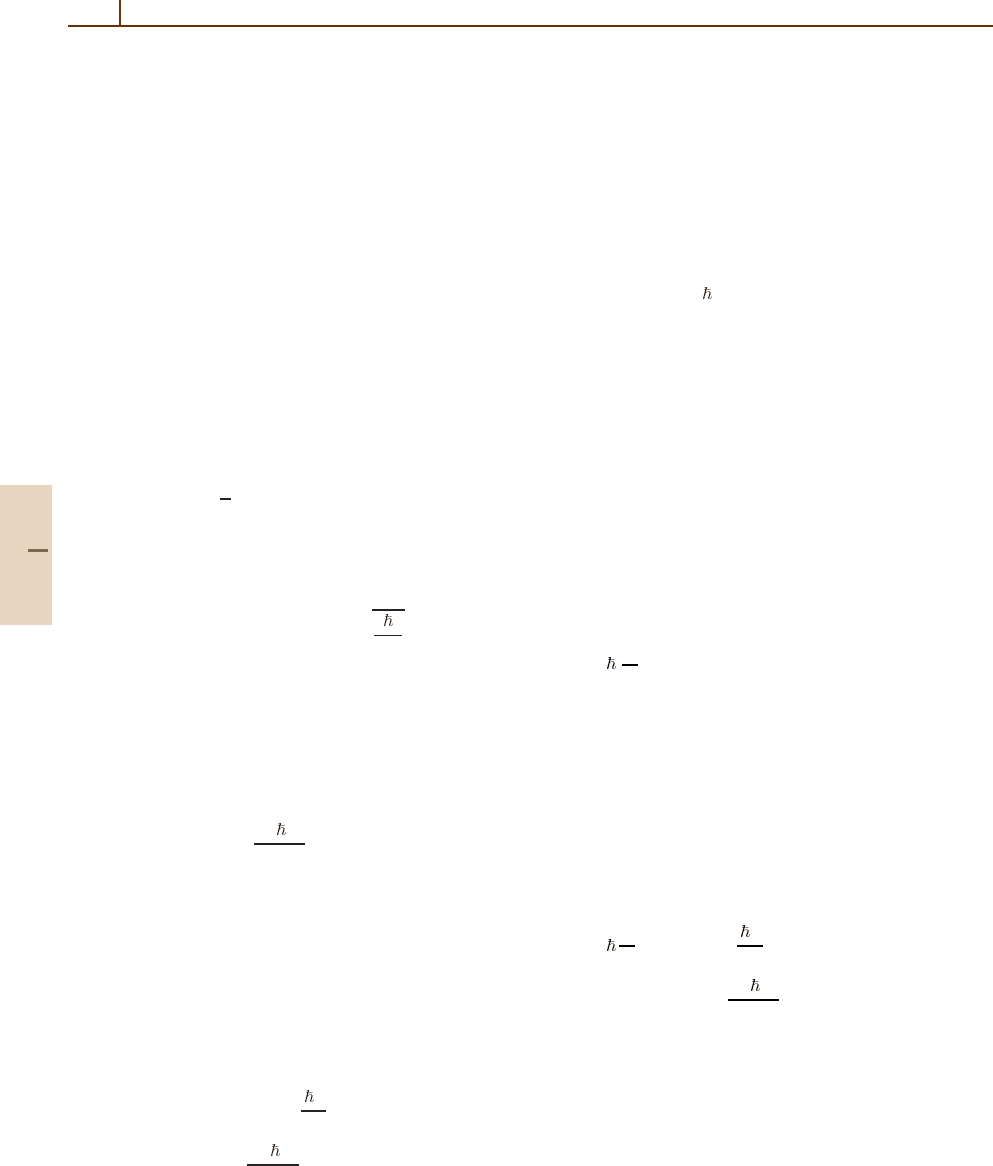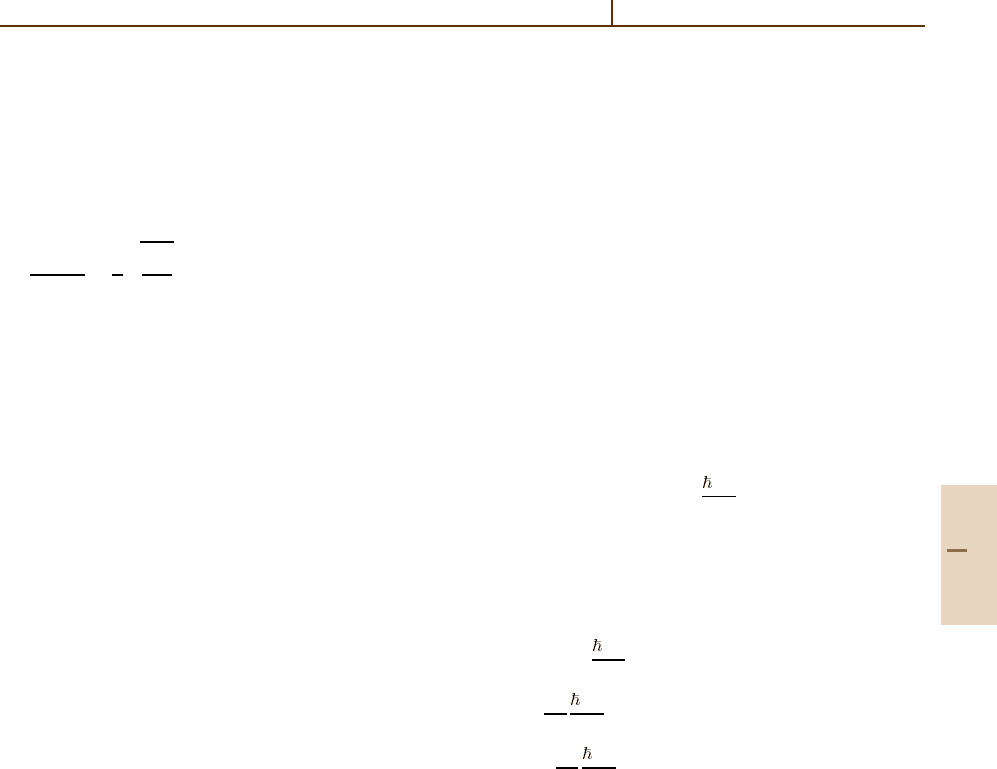Drake G.W.F. (editor) Handbook of Atomic, Molecular, and Optical Physics
Подождите немного. Документ загружается.


Quantum Degenerate Gases 76.1 Elements of Quantum Field Theory 1109
k ≡{p,α},wherep stands for quantum numbers of the
center of the mass and α for the quantum numbers of the
internal state, it is expedient to define a quantum field
for each species α as
ˆ
ψ
α
(x) =
p
u
pα
(x)a
pα
. (76.13)
Mechanisms that cause transitions between the internal
states couple the fields
ˆ
ψ
α
(x) for different α.
States of Bosons. To complete the transformation from
wave function quantum mechanics to second quantiza-
tion, the state of the system must be specified in second
quantization. For instance, take the Hamiltonian
ˆ
H and
the particle number operator
ˆ
N. According to statistical
mechanics a system characterized by the temperature T
and chemical potential µ is in the state with the density
operator
ˆ
ρ =e
−(
ˆ
H−µ
ˆ
N)/k
B
T
/Z, where the grand partition
function is Z = Tr e
−(
ˆ
H−µ
ˆ
N)/k
B
T
.
Bose–Einstein Condensate. The state of a boson sys-
tem of particular interest here is the BEC.Inanideal
gas condensation entails a macroscopic fraction of the
particles occupying the ground state of the c.m. motion.
Condensation is a phase transition that occurs when ei-
ther the density of the gas is increased or the temperature
is lowered. In a homogeneous ideal Bose gas the gov-
erning parameter is the phase space density ζ defined
as
ζ =
2π
2
mk
B
T
3/2
n , (76.14)
where m is the mass of the condensing atoms, T is
the temperature, and n is the density of the condensing
species. For the purposes of quantum degeneracy, each
internal state of an atom behaves as a separate species.
Bose–Einstein condensation takes place when the phase
space density satisfies ζ =2.612. Depending on whether
density or temperature is regarded as a constant, (76.14)
may be regarded as an equation for the critical tem-
perature T
c
or the critical density n
c
for Bose–Einstein
condensation.
76.1.2 Fermions
Particles with a half-integer angular momentum obey
the Fermi–Dirac statistics. Each Fock state may then
only have the occupation numbers n
k
= 0, 1. The con-
ventional definition of the annihilation operator contains
a phase factor,
a
k
|n
0
, n
1
,... ,n
k
,... ,n
∞
= n
k
(−1)
k−1
p=0
n
p
|n
0
, n
1
,... ,n
k
−1,... ,n
∞
,
(76.15)
and fermion operators are governed by the anticommu-
tator
[A, B]
+
≡ AB+BA (76.16)
rather than the commutator. For instance,
[a
k
, a
k
]
+
= 0,
a
k
, a
†
k
+
= δ
kk
. (76.17)
Except for the use of anticommutators in lieu of com-
mutators, all formal expressions for field operators and
one- and two-particle operators written down for bosons
in Sect. 76.1.1 remain valid as stated.
Degenerate Fermi Gas. A degenerate Fermi gas realized
in a dilute atom vapor is the fermion counterpart of
a BEC. The basic parameter of a free noninteracting
Fermi gas is the Fermi energy, the chemical potential at
zero temperature. It is given by
F
=
2
k
2
F
2m
; k
F
=
6π
2
n
1/3
, (76.18)
where n once more is the density for the relevant fermion
species. In the limit of zero temperature the Fermi gas
makes a Fermi sea; the states below the Fermi energy are
filled with one particle each, the states above the Fermi
energy are empty. The gas begins to show substantial
deviations from the Maxwell-Boltzmann statistics and
may be regarded as degenerate when the temperature is
below the Fermi temperature, T ≤ T
F
=
F
/k
B
. Except
for a numerical factor, in terms of density and tempera-
ture the condition T ≤ T
F
is the same as the condition
for Bose–Einstein condensation.
76.1.3 Bosons versus Fermions
Isotopes of alkali metals with an odd mass number
7
Li,
23
Na,
39
K,
85
Rb,
87
Rb,
133
Cs
make Bose–Einstein
gases, while isotopes with an even mass number
6
Li,
40
K
make Fermi–Dirac gases. Atoms are composite
particles consisting of fermions, and how they may act
as bosons is a legitimate question. Whether a satisfactory
formal answer to this question exists may be debat-
able, but in practice atoms seem to obey the correct
statistics in processes that do not expose their individual
constituents.
Part F 76.1

1110 Part F Quantum Optics
When two bosonic atoms with integer angular mo-
menta combine into a molecule, the molecule has an
integer angular momentum and behaves as a boson. On
the other hand, two fermionic atoms also make a bosonic
molecule. Models for this latter type of system are basic-
ally ad hoc since, at this point in time, no microscopic
theory for such a reorganization of the statistics exists.
Nonetheless, empirically, diatomic molecules formed by
combining two fermionic atoms indeed appear to be
bosons.
76.2 Basic Properties of Degenerate Gases
Atoms Are Trapped. Quantum degenerate alkali va-
pors are typically prepared in an atom trap. Close to
the bottom almost every trap is a three-dimensional
harmonic oscillator potential completely characterized
by the principal-axis directions and the corresponding
trap frequencies ω
i
, the (angular) frequencies at which
a single atom would oscillate back and forth in the given
principal-axis direction. In the principal-axis coordinate
system the trapping potential reads
V(x) =
1
2
3
i=1
mω
2
i
x
2
i
. (76.19)
It is convenient to introduce the characteristic harmonic-
oscillator frequency scale and the corresponding
harmonic-oscillator length scale as
¯
ω = (ω
1
ω
2
ω
3
)
1/3
,=
m
¯
ω
.
(76.20)
Atom–Atom Interactions. At low temperatures/ener-
gies only s-wave collisions are significant. In the theory
of quantum degenerate gases these are frequently repre-
sented by a pseudopotential tailored to give the correct
s-wave phase shift. For two atoms the atom–atom inter-
action is
u(x
1
, x
2
) =
4π
2
a
m
δ(x
1
−x
2
), (76.21)
where a is the s-wave scattering length. Qualitatively, the
scattering length is positive (negative) if the interaction
is repulsive (attractive).
Model Hamiltonian. Quantum field theory for a single-
component Bose gas usually starts with the Hamiltonian
ˆ
H =
d
3
x
ˆ
H (x), (76.22)
where the Hamiltonian density is
ˆ
H (x) =
ˆ
ψ
†
(x)
−
2
2m
∇
2
+V(x)
ˆ
ψ(x)
+
2π
2
a
m
ˆ
ψ
†
(x)
ˆ
ψ
†
(x)
ˆ
ψ(x)
ˆ
ψ(x). (76.23)
As in Sect. 76.1.1,
ˆ
ψ(r) is the boson field operator, the
kinetic energy −
2
∇
2
/2m and trapping potential V(x)
are one-particle operators, and atom–atom interactions
are governed by the two-body operator u of (76.21).
Analogous models can be written down for multicom-
ponent boson and fermion fields, for coupling between
atoms and molecules, and so on.
76.2.1 Bosons
Gross–Pitaevskii Equation
Mean-Field approximation. Conventionally, the next
step for bosons is to go over to the corresponding clas-
sical field theory. The result is referred to as mean-field
theory or semiclassical theory.
Formally, one first writes down explicitly the Heisen-
berg equation of motion for the boson field
ˆ
ψ,
i
∂
∂t
ˆ
ψ(x, t) =
ˆ
ψ(x, t),
ˆ
H
,
(76.24)
and then declares that in the equations of motion
ˆ
ψ →ψ
is a classical field not a quantum field anymore. We
call ψ the macroscopic wave function of the conden-
sate. This approximation is precisely analogous to using
the classical instead of the quantum description for the
electric and magnetic fields of the light coming out of
a laser.
Time-Dependent Gross–Pitaevskii Equation. The
time-dependent Gross–Pitaevskii equation (GPE)is
i
∂
∂t
ψ(r, t) =
−
2
2m
∇
2
+V(r)
ψ(r, t)
+
4π
2
a
m
|ψ(r, t)|
2
ψ(r, t). (76.25)
This equation is nonlinear, and normalization of the
macroscopic wave function ψ is important. Quantum
mechanically, the particle number operator is given
by (76.8), so that the normalization for a system with
N particles naturally reads
d
3
x |ψ(x, t)|
2
= N . (76.26)
Part F 76.2

Quantum Degenerate Gases 76.2 Basic Properties of Degenerate Gases 1111
Time evolution under (76.25) preserves the normaliza-
tion. Obviously, and in accordance with (76.9),
n(x) =|ψ(x)|
2
(76.27)
is the local density of the gas.
Time-Independent Gross–Pitaevskii Equation. So-
lutions to the time-dependent GPE of the form
ψ(x, t) = φ(x) e
−iµt/
are stationary states with no time
evolution in the physics. The analog of the energy of
a stationary state is called the chemical potential µ.
The corresponding wave function φ satisfies the time-
independent GPE
µφ =
−
2
2m
∇
2
+V
φ +
4π
2
a
m
|φ|
2
φ. (76.28)
Both GPEs are nonlinear variants of the Schrödinger
equation, and in other contexts they are often referred to
as nonlinear Schrödinger equations. The nonlinear term
approximates the interaction energy of an atom with
the other atoms in an averaged way by relying on the
local density of the atoms, hence the term mean-field
theory.
Sign of Scattering Length. The qualitative properties
of a condensate, as per the GPE, depend on the sign
of the scattering length. For repulsive atom–atom in-
teractions or no atom–atom interactions, a ≥0, both
the time-dependent and the time-independent forms are
mathematically well behaved. Unless otherwise noted,
the scattering length is always assumed non-negative.
In the case of a negative scattering length a BEC
may, in principle, decrease its energy without a bound
by collapsing to a point. Mechanisms such as three-body
recombination or molecule formation would eventually
set in as the density increases and the collapse would
stop, but the condensate must then be presumed lost.
In the absence of an external potential, a condensate
with a negative scattering length is unconditionally un-
stable against collapse. For a bounded condensate the
increase in the kinetic energy coming with the decreas-
ing size may hold off the collapse, provided the number
of atoms in the condensate is sufficiently small. Simple
dimensional-analysis arguments give the condition of
stability in a harmonic trap as N|a|
.
Behavior attributed to a collapse has been observed
in
7
Li for trapped states with a negative scattering
length. By using a Feshbach resonance it is also possible
to adjust the (apparent) scattering length (Sect. 76.5.1)
which has led to further demonstrations of collapse-like
physics.
Healing Length. Consider the time-independent
GPE (76.28) without an external potential, and scale
the various quantities as follows:
φ =
√
n
¯
φ, µ =
¯
µ
4π
2
na
m
,
x = ξ
¯
x; ξ =
1
√
8πna
. (76.29)
Here n is the density scale for the gas, and the length
scale is ξ. In terms of these new variables the time-
independent GPE reads
¯
µ
¯
φ =−
¯
∇
2
¯
φ +
¯
φ
2
¯
φ.
(76.30)
There is a solution in all of space with
¯
µ = 1,
¯
φ = 1. If
for some reason, such as at an edge of the sample, the
condensate wave function must vanish, the length scale
over which the wave function grows back to one (in the
scaled units) is of the order of unity. In fact, (76.30)has
the solution
¯
φ(
¯
x) =tanh
¯
z/
√
2
in the half-space
¯
z ≥ 0.
The quantity ξ is the minimum length scale over which
a condensate wave function can build up to the density n.
It is called the healing length.
Thomas–Fermi Approximation. Without atom–atom
interactions, the ground state of the trapping potential
V(x) would be the lowest-energy (lowest µ) solution
to (76.28). However, experience has shown that even
modest repulsive atom–atom interactions (a > 0) spread
out the macroscopic wave function of the condensate
a great deal. With increasing size comes decreasing
kinetic energy, according to the Heisenberg uncertainty
principle. This suggests the Thomas–Fermi approxima-
tion, in which the kinetic energy term in (76.28)issimply
ignored. The density of the gas is then easily solved to
be
n(x) =
m
µ −V(x)
4 π
2
a
,µ>V(x)
0, otherwise,
(76.31)
an inverted image of the trapping potential. The normal-
ization (76.26) can be used to find the relation between
chemical potential and particle number, and all of the
unknown quantities may, in principle, be found.
For a harmonic potential the Thomas–Fermi approx-
imation can be worked out explicitly with the results
µ =
1
2
¯
ω
15Na
2/5
, R =
15Na
1/5
,
n(0) =
1
8π
3
a
15Na
2/5
. (76.32)
Part F 76.2

1112 Part F Quantum Optics
The quantity R represents the size of the condensate. In
particular, it equals the radius of the spherical condensate
if the trap is isotropic with ω
1
= ω
2
= ω
3
. Finally, n(0)
is the central, maximum, density of the atoms.
The relevant dimensionless parameter is Na/,
which can easily be much larger than unity in the ex-
periments. When the Thomas–Fermi approximation is
accurate, the chemical potential exceeds the typical level
spacing of the harmonic-oscillator trap, and the conden-
sate is larger than the ground-state wave function of the
harmonic oscillator would be. Ordinarily, the condensate
is also much larger than the healing length.
Small Excitations in a BEC
Linearizing the GPE. The time-dependent GPE is
nonlinear, but may be linearized around a stationary
solution. Consider the special case without a trapping
potential, V(x) ≡0. The stationary solutions are plane
waves,
φ(x) =
√
n e
i p·x
. (76.33)
This corresponds to a flow of the gas at the velocity
v =
p/m and with a momentum p per atom. The
chemical potential of such a mode is
µ
=
p
+
1
2
0
, (76.34)
where
p
=
p
2
2m
,
0
=
mc
2
, c =
√
8πna
m
=
mξ
(76.35)
are the dispersion relation of free atoms, a peculiar ana-
log of the rest energy, and the speed of sound in the
BEC.
The ansatz for small deviations from the stationary
solution is written as
ψ(x, t) =
√
n e
i( p·x−
µ
t)
1 +u e
i(q·x−νt)
+v
∗
e
−i(q·x−ν
∗
t)
,
(76.36)
where q and ν are the momentum and energy associ-
ated with the excitation relative to the momentum and
energy of the original flow. The GPE mixes the field ψ
and its complex conjugate ψ
∗
,sothattwosmallam-
plitudes u and v are needed for the excitations. The
ansatz (76.36) is a solution to the time-dependent GPE
to the lowest nontrivial order in u and v if these am-
plitudes and the frequency of the excitation satisfy the
eigenvalue equation
q
+
0
+q ·v
0
0
q
+
0
−q ·v
u
v
= ν
u
−v
.
(76.37)
The remaining problem is that the eigenvalue equa-
tion has two solutions for each q, which gives twice
as many small-excitation modes as there are degrees of
freedom. The extra modes are the penalty one pays for
the linearization of the GPE. The criterion |u|
2
−|v|
2
> 0
picks out the correct small-excitation modes. The cor-
responding dispersion relation for the excitations is
ν(q) = q·v +
q
(
q
+2
0
). (76.38)
For a stationary BEC with v = 0 and in the limit q → 0,
(76.38)givesν cq. This confirms the identification
of c as the speed of sound.
In the BEC experiments the condensates are trapped,
but in principle the same analysis of small-excitation
modes may be carried out both numerically and in a myr-
iad of analytical approximations. The generic result is
that the trap frequencies lend their frequency scale to
small excitations. At low enough temperatures, excita-
tion frequencies calculated in this way agree well with
the experiments.
Within the mean-field approximation small excita-
tions may be analyzed similarly in all boson systems, for
instance, in a multi-component Bose–Einstein conden-
sate or a joint atom–molecule condensate. The evolution
frequencies may be complex, which signals a dynam-
ical instability of the stationary configuration; there are
small-excitation modes that grow exponentially. The in-
stability of a free gas with a negative scattering length,
which is apparent in (76.38)for
0
< 0, is a simple
example.
Bogoliubov Theory. Bogoliubov theory is the many-
body quantum version of the analysis of small
excitations. The idea is to treat the condensate mode ψ
0
,
containing n
0
atoms, separately in the field operator
ˆ
ψ =
√
n
0
ψ
0
+δ
ˆ
ψ, (76.39)
expand the Hamiltonian in the lowest nontrivial (second)
order in the remnant quantum field δ
ˆ
ψ, and diagonalize.
The result is small-excitation modes with the annihi-
lation operators A
k
,wherek stands for the appropriate
quantum numbers. It turns out that the core mathematics
of Bogoliubov theory is the same as the mathemat-
ics of small excitations, but two features are added.
Part F 76.2

Quantum Degenerate Gases 76.2 Basic Properties of Degenerate Gases 1113
First, Bogoliubov theory explicitly shows that the co-
efficients u and v in the analog of (76.37) need to satisfy
|u|
2
−|v|
2
= 1 to ensure boson commutators for the
operators A
k
. Second, with quantum fluctuations, atom–
atom interactions force atoms out of the condensate even
at zero temperature. In a homogeneous (untrapped) con-
densate, in the limit na
3
1, at T = 0, the fraction of
noncondensate atoms is
N −n
0
N
=
8
3
na
3
π
.
(76.40)
When the gas parameter na
3
is much smaller than
unity, at low enough temperatures most of the atoms are
in the condensate. Mean-field theory and the GPE are
expected to apply, and empirically, they do.
Numerical Methods for GPE
Mathematical Properties of the GPE. Let us momen-
tarily assume that by separation of variables, or by some
fiat, the problem of solving the time-independent GPE
has been rendered one-dimensional. The Schrödinger
equation is linear and any constant multiple of a solution
is also a solution. One parameter, e.g., the logarith-
mic derivate of the wave function at a given point in
space, determines a stationary state completely. This
does not hold for the corresponding GPE, for which the
values of the wave function and its derivative can be
specified independently at (almost) every fixed point in
space. As a result of the added flexibility, and unlike
the Schrödinger equation, the GPE has bounded solu-
tions for continuous ranges of the values of the chemical
potential µ.
However, the time-independent GPE (76.28)comes
with the added normalization condition (76.26). Nor-
malization quantizes the values of µ for the bound states.
In practice one might, for instance, find a solution that
satisfies the boundary conditions for a given µ with the
shooting method, then adjust the value of µ until nor-
malization holds. Techniques used in the first numerical
analyses of the time-independent GPE in the context of
atom vapor condensates were variations of this theme.
Such schemes are not feasible in spatial dimensions
greater than one.
In general there is one solution to the time-
independent GPE that can be chosen to be positive
everywhere, the ground state with the lowest chemical
potential. Excited steady states exist, but only a few,
such as the flowing states of (76.33) and vortices dis-
cussed in Sect. 76.4.1, have obvious physical meanings.
As the GPE is nonlinear, excited states are not the same
as small excitations.
Split-Step Fourier Method. The superposition principle
does not hold for the solutions of the time-dependent
GPE, and the excited states are usually not orthogonal
to one another in any useful sense. Methods based on
eigenstate expansions for solving the time-dependent
GPE are cumbersome at best. Instead, one often sim-
ply integrates the GPE as a partial differential equation
in time. A number of different methods are used, but
here we only discuss an elementary split-step Fourier
method [76.7]. This is an exceedingly popular algorithm
for parabolic equations, easy to implement, and with
minor modifications also solves the time-independent
GPE in any number of dimensions.
Thus, consider integration of (76.25) forward in time
over a step from t to t +∆t. For this purpose assume first
that |ψ|
2
in the GPE were a constant equal to its value
at time t, then the evolution over the time step ∆t would
be given by
ψ(x, t +∆t) =exp
−i∆t
−
∇
2
2m
+U(x)
× ψ(x, t),
(76.41)
where U(x) is a given function of position. In the al-
gorithm the exponential is first split approximately, for
instance, as
exp
−i ∆t
−
∇
2
2m
+U(x)
exp
i
∆t
2
∇
2
2m
exp
−i ∆tU(x)
×exp
i
∆t
2
∇
2
2m
≡
˜
T
˜
U
˜
T .
(76.42)
The exponential of the kinetic-energy operator is diago-
nal in the Fourier representation. Consequently, carrying
out the Fourier transform F and its inverse with the aid
of the Fast Fourier Transformation gives the split-step
algorithm
ψ(t +∆t) = F
−1
˜
TF
˜
UF
−1
˜
TF ψ(t)
(76.43)
with obvious efficient implementations. The inaccurate
constant |ψ|
2
may be improved upon in a corrector
step in which the average of the initial wave func-
tion ψ(t) and the ψ(t +∆t) obtained in the first pass
is used as |ψ|
2
,andstep(76.43) is taken again. This
split-step algorithm preserves the normalization of the
macroscopic wave function, and features a high-order
approximation to the exponential operator of the kinetic
energy.
Part F 76.2

1114 Part F Quantum Optics
Integration in Imaginary Time. The split-step algo-
rithm also provides a global method to find the ground
state. To this end the time-dependent GPE is integrated
in imaginary time, i. e., replacing ∆t →−i∆t, starting
from a more or less random initial wave function and
normalizing after every step. If the GPE were linear, this
procedure would emphasize the lowest-energy compon-
ent of the wave function until it is the only one that
remains to within a prescribed accuracy. It is not clear
that the same should apply to the nonlinear GPE,but
often this is the case.
In nonlinear problems, split-operator methods, in
spite of their seeming simplicity, often exhibit spurious
behavior. Successful applications of these techniques
require skill and experience in the art of numerical
methods.
Local-Density Approximation
While an experimental BEC is usually trapped, it is often
much easier to study the theory for a formally infinite ho-
mogeneous condensate. As long as the phenomena under
investigation involve length scales much smaller than the
size of the condensate and time scales much shorter than
the inverse trap frequencies, trapping cannot affect the
behavior of the gas locally. Under such conditions one
may analyze the gas at each position x as if it were ho-
mogeneous, and at the end of the calculations average
over the density distribution. The unit-normalized dis-
tribution of the density of the gas used in the averaging
is
P() =
δ
−n(x)
n(x) d
3
x
n(x) d
3
x
.
(76.44)
For instance,
P() =
15
n
0
−
4n
5/2
0
H()H(n
0
−) (76.45)
holds for the Thomas–Fermi approximation with the
maximum density n
0
≡ n(0). The Heaviside step func-
tions H restrict the density to the correct range
0 ≤ ≤ n
0
. As an example, the average density in the
Thomas–Fermi model is
P() d =
4
7
n
0
. (76.46)
76.2.2 Meaning of Macroscopic
Wave Function
Here the macroscopic wave function ψ has been intro-
duced by replacing a boson field theory with a classical
field theory.
The intuitive interpretation is that, for interacting
particles, the atoms condense not to the ground state
of the confining potential, but to the one-body state
whose wave function is the macroscopic wave func-
tion. This notion may be criticized on various grounds,
but in practice it makes a useful picture.
A precise formal meaning of the macroscopic wave
function, and of Bose–Einstein condensation for inter-
acting systems, is found by considering the one-particle
density matrix
ρ(x, x
) =
ˆ
ψ
†
(x)
ˆ
ψ(x
)
, (76.47)
which is sufficient to determine the expectation value
of any one-particle operator. This is the position repre-
sentation of a positive Hermitian operator with the trace
equal to particle number (or its expectation value) N.In
this way, with an orthonormal set of functions {ψ
k
(x)}
k
and nonnegative eigenvalues n
k
, such that
k
n
k
= N , (76.48)
an expansion of the form
ρ(x, x
) =
k
n
k
ψ
k
(x)ψ
k
(x
) (76.49)
exists. The system is a BEC if at least one eigen-
value n
k
is of the order of the number of particles and
does not formally go to zero in the thermodynamic
limit (if the limit exists and is sensible). The usual
case is that only one eigenstate, call it k = 0, has such
a large eigenvalue. The macroscopic wave function is
the corresponding eigenfunction ψ ≡ ψ
0
,andn
0
gives
the number of condensate atoms. If there is more than
one macroscopic eigenvalue, the condensate is called
fragmented.
Another interpretation of the macroscopic wave
function comes from statistical mechanics. In a continu-
ous (second-order) phase transition typically a symme-
try of the system is spontaneously broken. For example,
below the Curie temperature a single-domain ferro-
magnet magnetizes in some specific direction, and the
state has a lower symmetry than the rotationally in-
variant Hamiltonian of an isotropic ferromagnet. Any
quantity that appears in a continuous phase transition
and characterizes the breaking of the symmetry may
be called an order parameter. The macroscopic wave
function can be viewed as the order parameter asso-
ciated with spontaneous breaking of the global phase
or “gauge” symmetry of quantum mechanics. Specific-
ally, in quantum mechanics the state of the system is
Part F 76.2

Quantum Degenerate Gases 76.3 Experimental 1115
unchanged if the wave function is multiplied by an ar-
bitrary complex phase factor e
iϕ
. But to write the wave
function as ψ(x) already implies a preferred phase, and
likewise even if the wave function is adorned with ran-
dom but, for any given condensate, fixed phase, as in
e
iϕ
ψ(x).
For one condensate the random phase is inconse-
quential. Suppose, however, that two BECs with the
wave functions e
iϕ
1
ψ
1
(x) and e
iϕ
2
ψ
2
(x) are combined.
If the macroscopic wave functions behave as wave
functions should, the combination of two condensates
displays the density n(x) =|e
iϕ
1
ψ
1
(x) + e
iϕ
2
ψ
2
(x)|
2
.
There should be an interference pattern between the
condensates. Two BECs indeed produce an interference
pattern when they are combined, although the random-
ness or the absence thereof of the phases ϕ
1,2
is difficult
to verify experimentally.
From the quantum optics viewpoint, a condensate is
a given number of atoms in a given one-particle state,
a number state, and cannot possess any phase at all. This
seems to contradict the observations of an interference
pattern. The resolution is that the process of measure-
ment in itself produces a phase difference between the
condensates even if there initially is none.
76.2.3 Fermions
Static Fermi Gas
Thomas–Fermi Approximation. Consider an ideal
single-species Fermi gas of trapped atoms. The origi-
nal Thomas–Fermi approximation (see Chapt. 20)was
formulated for fermions, namely, electrons, and in the
present case it is modified as follows. For the atom
density n(x) at position x, at a low temperature, the
corresponding local internal chemical potential is ap-
proximated according to (76.18)as
F
(x) =
2
6π
2
n(x)
2/3
2m
.
(76.50)
Given the trapping potential V(x), the density of the gas
adjusts in such a way that the sum of the external poten-
tial energy and the local internal chemical potential, the
Fermi energy, is a constant across the gas,
V(x) +
2
6π
2
n(x)
2/3
2m
= µ,
(76.51)
the global chemical potential. One may solve the density
for a given chemical potential as
n(x) =
√
2 m
3
2
µ −V(x)
3
2
3 π
2 3
, V(x)<µ;
0, otherwise.
(76.52)
Finally, the integral of the density over all space should
equal the atom number, which gives an equation to
determine the chemical potential µ.
For a harmonic trap this program can be carried out
in an exact, analytical manner with the result that
µ = 6
1/3
N
1/3
¯
ω, R = 2
2/3
3
1/3
N
1/6
,
n(0) =
2
√
N
√
3π
2
3
. (76.53)
The quantities
¯
ω, ,andR have the same meaning as
in the BEC case. The Thomas–Fermi approximation for
fermions should be applicable whenever N 1.
In a one-component Fermi gas at low tempera-
ture atom–atom interactions are typically negligible for
a multitude of reasons. There is no s-wave scattering,
and the presence of the Fermi sea tends to suppress re-
pulsive interactions. However, in the case of attractive
interactions between two species, the Fermi sea may be
thermodynamically unstable; the energy may be low-
ered by pairing fermions into Cooper pairs. This is the
mechanism behind the BCS theory of superconductiv-
ity [76.8].
Excitations in a Fermi Gas
If the interactions do not render a fermion system into
a superfluid, see Sect. 76.5.1, the elementary excitations
of a degenerate Fermi gas with short-range interactions
are basically atom–hole pairs. What happens in the con-
trary case for trapped and strongly interacting atoms is
presently an active area of research.
76.3 Experimental
76.3.1 Preparing a BEC
In a trapped gas the density n(x) is self-determined from
the atom number N, and the condition for a BEC in an
ideal gas is most readily expressed in terms of the total
number of atoms as
k
B
T
c
= 0.94
¯
ωN
1/3
. (76.54)
Part F 76.3

1116 Part F Quantum Optics
In practice, at the bottom of the trap the conditions on
temperature and density for a BEC are similar to the con-
ditions for a BEC in a free gas. In the thermodynamic
limit, such that
¯
ω → 0, N →∞with
¯
ωN
1/3
held con-
stant, below the critical temperature T
c
the fraction of
condensate atoms behaves as a function of temperature T
as
n
0
N
= 1 −
T
T
c
3
. (76.55)
The experimental realizations of alkali vapor con-
densates are based on techniques of laser cooling and
trapping of atoms. The following discussion relies heav-
ily on material from Chapt. 75.
A BEC in a dilute atomic gas is usually prepared
using a two-stage process. First, a magneto-optical trap
is used to capture a sample of cold atoms and to cool it to
a temperature of the order of a few tens of microkelvin.
The atoms are then transferred to a magnetic trap for
evaporative cooling that leads to condensation.
A magnetic trap is based on a combination of two
ideas. First, if an atom that starts out with its magnetic
moment antiparallel to the magnetic field moves slowly
enough in a position dependent magnetic field, its mag-
netic moment remains adiabatically locked antiparallel
to the magnetic field. The energy of the atom is then
a minimum where the magnetic field is a minimum.
Second, the absolute value of the magnetic field may
have a minimum in free space. The minimum is then
a trap for atoms whose magnetic moments are suitably
oriented. The downside is that only atoms in the right
magnetic (Zeeman) states are trapped. While the atoms
cool down, they accumulate at the center of the trap.
The center should not be a zero of the magnetic field,
because at zero field an atom would lose the lock be-
tween the directions of the magnetic moment and the
magnetic field necessary for trapping.
A time orbiting potential (TOP) trap starts with the
same kind of magnetic field that is used in a magneto-
optical trap. A time-dependent magnetic field is then
added in such a way that the zero of the magnetic field
orbits around the center of the trap. If the frequency at
which the zero orbits is high enough so that the atoms
cannot follow, they see an effective potential with a min-
imum at the center of the trap and do not sample the
zero. Alternatively, it is possible to wind a coil in such
a way that it makes a magnetic field whose absolute
value has a minimum that is not zero. In this type of
a Ioffe–Pritchard trap the winding of the wire resembles
the seams on a US baseball.
The basic idea of evaporative cooling is that the most
energetic atoms escape from the trap, then the remaining
atoms thermalize to a lower temperature. Some atoms
are lost in the process, but with the decreasing tem-
perature the density at the trap center nonetheless tends
to increase and the phase space density increases even
more due to the cooling.
The cooling is usually forced by an rf drive. The tran-
sition frequency between the Zeeman states depends on
the magnetic field, and increases toward the edges of
the trap. Atoms are removed where the rf frequency is
on resonance and drives transitions to untrapped Zee-
man states. Thus, while the atoms cool and concentrate
at the center, the radio frequency is swept down in such
a way that the “rf knife” removing the atoms slides
in from the edge of the trap. At some radio frequency
a condensate abruptly emerges. The temperature can be
further lowered by continuing evaporative cooling, al-
beit at the expense of loss of atoms. As a rule of thumb,
an atom needs to experience a hundred collisions before
condensation occurs, and a typical time needed to pre-
pare a condensate is a few seconds. In a good vacuum
a condensate may live for tens of seconds.
It is also possible to condense atoms trapped in a far-
off resonant optical trap based on the dipole forces of
light, instead of the magnetic trap [76.9]. For tuning
below the resonance, atoms are strong-field seekers.
A focused laser beam is a three-dimensional trap for
atoms, as is an arrangement with two crossed beams
focused to the same spot. Furthermore, with extreme
off-resonant light from a CO
2
or a Nd-YAG laser, ab-
sorption of photons and the associated photon recoil
kicks and heating may be negligible.
An optical trap may also be added after a BEC is
prepared in a magnetic trap. The advantage is that an op-
tical trap will hold the atoms regardless of their magnetic
state, so that multicomponent “spinor” condensates may
be studied. Moreover, while an adiabatic change of the
strength of a trap cannot change the phase space dens-
ity, the phase space density may be altered by changing
the shape of the trap by adding a tight optical trap to
the bottom of a much wider magnetic trap. Reversible
condensation inside an added optical subtrap based on
such an increase in the phase space density has been
demonstrated.
Methods to condense atoms that might be suited
for future technological applications are being pursued.
For instance, by lithographic techniques it is possible
to put conducting wires on a substrate to make an
atom chip. With currents flowing, the wires produce
magnetic fields that guide the atoms. Condensation
Part F 76.3

Quantum Degenerate Gases 76.4 BEC Superfluid 1117
in such a configuration has been reported [76.10].
Two-dimensional condensation in what is known as
a gravito-optical surface trap has also been achieved
experimentally [76.11].
There is an analogy between a condensate and
a beam of light from a laser that we rely on extensively.
However, the analogy is only partial. By dropping a con-
densate under gravity one makes a pulsed atom laser,
and by coupling a trapped Zeeman state to an untrapped
state by rf excitation it is possible to make a conden-
sate leak slowly out of the trap. Nonetheless, at this
time a method to produce a continuous beam of conden-
sate atoms, a continuous-wave atom laser, is yet to be
demonstrated.
76.3.2 Preparing a Degenerate Fermi Gas
A single-species, very-low temperature Fermi gas is an
uninteresting system, as the Fermi–Dirac statistics for-
bids s-wave interactions between the atoms and the gas
is nearly ideal. In experiments the gas usually has two
species, different states of the same atom. The interac-
tions between the species are comparable in strength to
the interactions between bosonic atoms.
Evaporative cooling works in a two-species gas, and
can be used to prepare a degenerate Fermi gas either
in a magnetic trap [76.12] or in an optical trap [76.13].
Second, one can use a gas of bosons, and indeed a BEC,
as a refrigerator [76.14]. At this writing the lowest tem-
peratures are of the order of 0.1 T
F
. Reaching lower
temperatures is complicated by various factors, such as
the very low heat capacity of a BEC and collisions be-
coming inefficient at low temperature because the inert
Fermi sea reduces the available phase space. Nonethe-
less, lower temperatures seem to be mainly a matter of
advances in technology.
76.3.3 Monitoring Degenerate Gases
Orders of Magnitude. As a rule of thumb, the trapping
frequencies in a magnetic trap are
¯
ω ≈ 2π × 10 Hz, while
the frequencies in an optical trap may reach into the kHz
regime. A typical oscillator length is ≈1 µm. A usual
number of atoms is N ≈ 10
6
. Scattering lengths are of
the order of a ≈10 nm. The size of a degenerate gas
is in the neighborhood of R ≈0.1 mm, the maximum
density is about n
0
≈10
15
cm
−3
,andtheBEC transition
temperature and the Fermi temperature are of the order
of T
c
≈ T
F
≈ 1 µK. However, much lower temperatures
are readily reached in a BEC.
Phase Contrast Imaging. It is possible to monitor con-
densate features substantially larger than the wavelength
of the light used in the measurements nondestructively,
in situ, by using phase contrast imaging. In this method
the light is detuned far off resonance so that absorptions
with the accompanying photon recoil kicks on the atoms
are rare, but the phase of the light nonetheless changes
upon propagation through the sample. The phase change
may be detected by interfering the transmitted light with
the original light, with the phase of the latter suitably
shifted.
Time-of-Flight Imaging. Usually, though, the obser-
vation of a degenerate gas at the end of an experiment is
by time-of-flight imaging. The trap is suddenly removed,
whereupon the gas expands freely. After the atom cloud
has grown to a size large enough compared to the wave-
length of the resonant light used to monitor the gas, an
absorption image of the cloud is taken. This gives the
projection of the density of the gas onto a plane per-
pendicular to the direction of propagation of the light.
Except for the effects of atom–atom interactions, after
a sufficiently long time of free flight the density reflects
the initial momentum distribution of the atoms. Time-
of-flight images bear the signs of both condensation in
a Bose gas and quantum degeneracy in a Fermi gas. Non-
trivially, other features of interest such as vortex cores
are also preserved and can be detected after the free ex-
pansion. The downside is that the time-of-flight method
is destructive. After each snapshot the sample will have
to be prepared again.
76.4 BEC Superfluid
76.4.1 Vortices
Flow Velocity in a Superfluid. By manipulating the
Heisenberg equations of motion for a Bose field under
the Hamiltonian (76.22) it is easy to derive the equation
of continuity for the atoms,
∂
∂t
ˆ
n+∇·
ˆ
J = 0 ,
(76.56)
ˆ
n =
ˆ
ψ
†
ˆ
ψ,
ˆ
J = i
2m
ψ∇ψ
†
−ψ
†
∇ψ
, (76.57)
Part F 76.4

1118 Part F Quantum Optics
which identifies
ˆ
n and
ˆ
J as the operators for atom density
and atom current density. The corresponding mean-field
quantities are obtained when again the boson fields are
replaced with the corresponding classical fields. Writing
the classical field in terms of the density n(x, t) and phase
ϕ(x, t) in the form
ψ =
√
n e
iϕ
, (76.58)
the local flow velocity v = j/n becomes
v =
m
∇ϕ.
(76.59)
The velocity field is irrotational.
Quantization of Circulation. Integration of the flow
velocity around an arbitrary loop gives
dl·v =
m
∆ϕ = p
2π
m
,
p = 0, ±1, ±2,... ,
(76.60)
since the change of the phase ∆ϕ around a closed loop
must be an integer multiple of 2π. Equation (76.60)
expresses the quantization of circulation in a superfluid.
A medium described by a macroscopic wave function,
such as a BEC, cannot sustain arbitrary flow velocities.
Vortices. As an example, in bulk rotation at an angu-
lar velocity Ω the line integral around a loop at the
distance r from the axis of rotation would be 2πr
2
Ω,
which is not permitted for an arbitrary r. Instead, upon
an attempt to make a BEC rotate, the angular velocity
will be carried by vortex lines. These are lines through
the condensate, entering and exiting at the surface, such
that each vortex carries one quantum of circulation. At
the core of a vortex the flow velocity should be infinite
to sustain a finite circulation, which is physically impos-
sible. Nature solves this problem by making the vortex
core normal (not BEC), so that the macroscopic wave
function does not apply. The diameter of the vortex core
is of the order of the healing length ξ,givenby(76.29).
When the trapping potential on the atoms is rotated,
it is convenient to study the physics in the co-rotating
frame. Given a frame rotating at the angular velocity Ω
and the angular momentum operator L = x× p per par-
ticle, transformation to the rotating frame adds the
one-particle term
H
r
=−Ω · L (76.61)
to the Hamiltonian. Any particular configuration of vor-
tices is a thermodynamically stable equilibrium if it is
the minimum of energy in the co-rotating frame. For
a trapped condensate, at zero rotation velocity the state
without vortices is the energy minimum, and increas-
ing the rotation speed makes states with an increasing
number of vortices the stable configuration. However,
a vortex configuration may be metastable and live for
a long time even if it is not the minimum of energy.
Conversely, even the energy-minimum configuration of
vortices must first be nucleated. Since the circulation
can only have quantized values, it cannot change in
a continuous process. It takes a zero condensate density
somewhere to create or destroy a vortex.
These alternatives provide a large number of experi-
mental scenarios involving rotation of the trap or stirring
of the condensate, condensation of a rotating normal gas
by taking it across the transition temperature, and so
forth. For instance, when a trap containing a BEC is ro-
tated, vortices are generated at the surface where they
start their lives as dynamical instabilities. The vortices
then drift in and form a regular vortex array [76.15].
When the rotation is halted, the vortices drift out to the
surface and disappear.
76.4.2 Superfluidity
A BEC also has the remarkable property that it may sus-
tain persistent currents that are completely immune to
viscosity. The qualitative reason may be seen from the
dispersion relation of small excitations (76.38). As long
as the flow speed |v| is less than the speed of sound c,all
excitation energies are positive, so that the flowing state
is the state of lowest energy and is thermodynamically
stable. On the other hand, when the flow velocity ex-
ceeds the speed of sound, the system has excitations that
lower the energy, ν(q)<0forsomeq. The flowing state
is then not a minimum of energy. The flow is not ther-
modynamically stable, and it decays when it interacts
with an environment by sending off small excitations.
The speed of sound gives the Landau critical velocity
for superfluidity.
The critical velocity c tends to zero when the
atom–atom interactions vanish with a → 0. While the
condensate wave function may be written down whether
the atoms interact or not, superfluidity and persistent
flows rely on the interactions. The same applies to vor-
tices, as in the limit of a noninteracting gas the healing
length and the radius of the vortex core tend to infinity.
The conventional picture is that superfluid flow in
an inhomogeneous medium is unstable if the local flow
velocity exceeds the local (density dependent) speed of
sound. In practice, in liquid He experiments and nu-
merical simulations of dilute condensates the current
Part F 76.4
